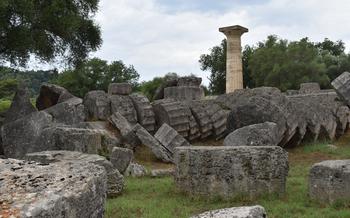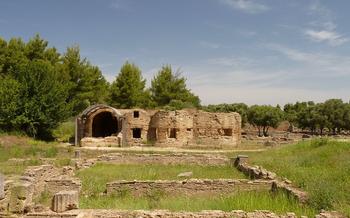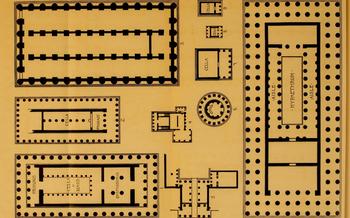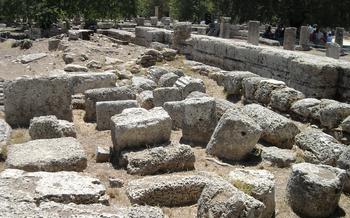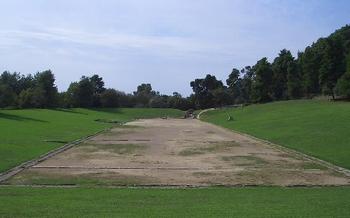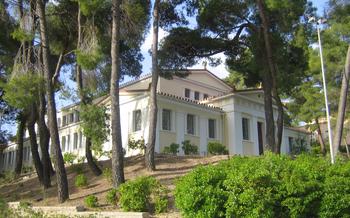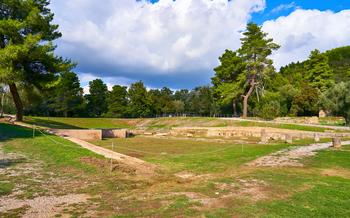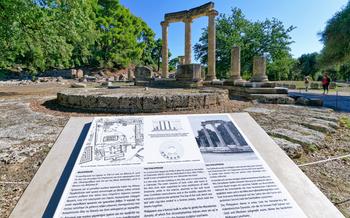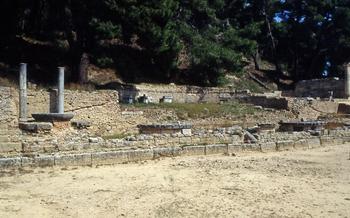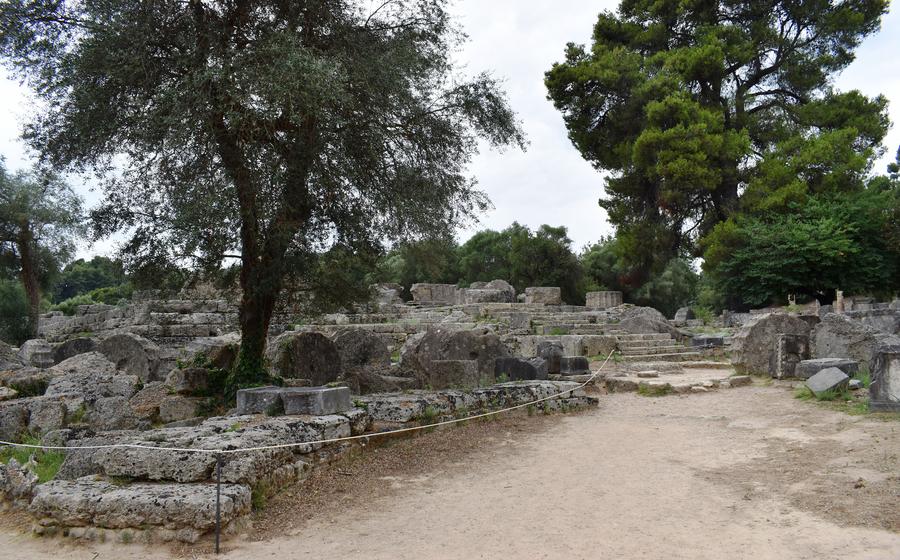
Folk Art Museum of Olympia
- Olympia: A Historical and Cultural Treasure
- Location and Getting There
- Hours of Operation and Admission
- Exploring the Museum
- Traditional Costumes and Textiles:
- Handcrafted Ceramics and Pottery:
- Woodcarvings and Sculptures
- Metalwork and Jewelry:
- Embroidery and Weaving
- Basketry and Straw Work
- Local Traditions and Folklore
- Temporary Exhibitions and Workshops
- Museum Shop and Souvenirs
- Accessibility and Facilities
- Insider Tip:
Olympia: A Historical and Cultural Treasure
Olympia, nestled in the Peloponnese region of Greece, is not just the birthplace of the Olympic Games; it's a treasure trove of history and culture. The region boasts a rich heritage, dating back to ancient times, with significant contributions to art, architecture, and craftsmanship. Among the cultural gems of Olympia is the Folk Art Museum, which provides a fascinating glimpse into the traditional arts and crafts of Greece.
Location and Getting There
The Folk Art Museum of Olympia is conveniently situated in the heart of Olympia, a short walk from the ancient Olympic stadium and the Archaeological Museum of Olympia. To reach the museum, you can either drive or take public transportation. If driving, simply follow the signs to Olympia and then to the museum. There is ample parking available near the museum.
If you prefer to take public transportation, there are regular buses from Athens and other major cities in Greece to Olympia. Once in Olympia, you can take a taxi or walk to the museum. The walk takes about 15 minutes and is a great way to explore the town and see some of the other historical sites.
Hours of Operation and Admission
The Folk Art Museum of Olympia is open to the public from 8:00 AM to 3:00 PM, Tuesday through Sunday. It is closed on Mondays and on national holidays. Admission fees are as follows:
- Full Price: €6
- Reduced Price: €3 (for students, seniors, and groups of 10 or more)
- Free Admission: For children under 6 years old and for visitors with disabilities
The museum offers guided tours in English, French, German, and Spanish for an additional fee of €2 per person. Audio guides are also available in several languages for a fee of €1 per person. Guided tours are available at specific times of the day and should be booked in advance to avoid disappointment.
During peak season (July and August), the museum may extend its hours to accommodate the increased number of visitors. It's recommended to check the museum's official website or contact them directly for the most up-to-date information on opening hours and admission fees.
Exploring the Museum
The Folk Art Museum of Olympia presents its vast collection through a well-organized layout, allowing visitors to seamlessly navigate different sections and discover the diverse range of exhibits. Interactive displays and informative panels enhance the experience, providing insights into the history and significance of each artifact.
Guided tours and audio guides are available for those who prefer a more in-depth exploration. These guided tours offer a deeper understanding of the museum's highlights and the stories behind the exhibits. Highlights include intricate wood carvings, vibrant textiles, and traditional costumes that showcase the region's rich cultural heritage.
Must-see exhibits include the impressive collection of traditional Greek costumes, which showcases the artistry and craftsmanship of local artisans. Visitors can admire the intricate embroidery, delicate lacework, and vibrant colors that adorn these garments. The museum also features a section dedicated to ceramics and pottery, where visitors can witness the evolution of pottery designs and techniques over time.
Traditional Costumes and Textiles:
The Folk Art Museum of Olympia proudly showcases an exceptional collection of traditional Greek costumes and textiles, offering visitors a glimpse into the rich cultural heritage of the region. These intricate garments, adorned with vibrant colors, intricate embroidery, and unique patterns, tell the story of Greece's diverse ethnic groups and their customs. The museum's collection features a wide array of costumes, from everyday wear to elaborate ceremonial attire, providing insights into the lives and traditions of the Greek people.
Visitors can admire the exquisite craftsmanship and attention to detail that went into creating these garments. The variety of materials used, including wool, cotton, silk, and linen, reflects the region's diverse geography and climate. Each costume holds a special significance, whether it's a wedding dress, a festive outfit, or a symbol of regional identity. The intricate embroidery and embellishments on the garments showcase the skills and artistry of local artisans, who have passed down these techniques from generation to generation.
Handcrafted Ceramics and Pottery:
The Folk Art Museum of Olympia houses an impressive collection of handcrafted ceramics and pottery items, showcasing the diverse talents and traditions of local artisans. These exquisite creations range from intricately painted vases and plates to decorative figurines and utilitarian cookware. Visitors can admire the unique styles and techniques employed by potters from various regions of Greece, each with its own distinct character.
The museum's pottery collection features traditional methods of ceramic making, passed down through generations. Ancient techniques such as wheel throwing, hand-building, and glazing are still practiced by contemporary potters, ensuring the perpetuation of this age-old craft. The exhibits highlight the evolution of pottery designs and techniques over time, providing a glimpse into the rich history and cultural significance of Greek pottery.
Woodcarvings and Sculptures
The Folk Art Museum of Olympia proudly showcases an exquisite collection of wood carvings and sculptures, each piece a testament to the artistry and skill of local craftsmen. These intricate works of art depict a variety of subjects, from religious figures and mythological scenes to everyday life and local traditions.
The techniques employed in these carvings are as diverse as the subjects themselves, with some pieces featuring intricate geometric designs while others display a more naturalistic style. The tools used are simple yet effective, with chisels, gouges, and knives being the primary implements.
The carvings often hold symbolic meanings or tell stories from Greek mythology and folklore. For example, a carving of a centaur might represent the wild and untamed aspects of nature, while a depiction of a mermaid could symbolize the allure of the sea.
These woodcarvings and sculptures offer visitors a glimpse into the rich cultural heritage of Olympia and the surrounding region. They are a testament to the creativity and skill of local artisans, and they continue to inspire and captivate visitors from around the world.
Metalwork and Jewelry:
The Folk Art Museum of Olympia proudly showcases an array of intricate metalwork and jewelry pieces, representing the diverse talents and traditions of Greek artisans from various regions. Explore the shimmering collection of silverware, intricately designed by skilled silversmiths. Admire the delicate goldsmithing techniques employed in crafting exquisite jewelry, adorned with precious stones and intricate filigree work. Each piece tells a story of cultural heritage, reflecting the rich history and artistry of Greek metalwork and jewelry-making.
Embroidery and Weaving
The Folk Art Museum of Olympia boasts a remarkable collection of embroidered and woven textiles, showcasing the intricate artistry and craftsmanship of the region. These stunning creations are a testament to the rich cultural heritage of Greece and the enduring skills of its artisans.
In the embroidery section, visitors can admire a variety of traditional motifs, patterns, and colors, each telling a unique story. From delicate cross-stitch and needlepoint to intricate lacework, these pieces demonstrate the patience and precision of the embroiderers.
The museum also houses a collection of woven textiles, including rugs, blankets, and tapestries. These pieces showcase the diversity of techniques used by local weavers, from simple loom weaving to more complex patterns and designs. The vibrant colors and intricate patterns of these textiles reflect the rich cultural heritage of the region and the creativity of its weavers.
These embroidered and woven pieces are not just decorative but also hold significant cultural and historical value. They were often used to adorn traditional costumes, celebrate special occasions, or commemorate important events. By preserving and showcasing these textiles, the Folk Art Museum of Olympia plays a vital role in safeguarding the region's cultural heritage and ensuring that these traditional crafts continue to thrive.
Basketry and Straw Work
The Folk Art Museum of Olympia also houses a remarkable collection of basketry and straw work that showcases the ingenuity and creativity of local artisans. These intricate items range from sturdy baskets and mats to decorative pieces that highlight the unique techniques and materials used in this traditional craft.
Visitors can admire the intricate weaving patterns, delicate textures, and vibrant colors that characterize these handmade creations. The museum's collection includes examples of traditional techniques such as coiling, twining, and plaiting, each demonstrating the skill and patience required to craft these functional and beautiful objects.
From simple, utilitarian baskets used for everyday tasks to elaborate decorative pieces adorned with intricate designs, the museum's basketry and straw work collection offers a glimpse into the rich cultural heritage of the region. These items not only serve as practical tools but also hold cultural significance, representing the ingenuity and creativity of the local communities.
Local Traditions and Folklore
The Folk Art Museum of Olympia not only showcases tangible artifacts but also delves into the intangible cultural heritage of the region. It features exhibitions that highlight local traditions, folklore, and customs, providing visitors with a glimpse into the rich cultural tapestry of the area. Through captivating displays and storytelling, the museum brings to life the folk tales, legends, and stories that have been passed down through generations. These exhibitions celebrate the unique customs and rituals that have shaped the identity of the region, emphasizing the importance of preserving and celebrating this living heritage.
Temporary Exhibitions and Workshops
The Folk Art Museum of Olympia occasionally hosts temporary exhibitions that showcase the works of contemporary Greek artists and artisans. These exhibitions provide a platform for emerging talents to display their skills and creativity, while also offering visitors the opportunity to witness the evolution of traditional crafts in modern times. The museum also organizes workshops and demonstrations where visitors can learn firsthand about the techniques and processes involved in creating these beautiful objects. These workshops are led by experienced craftsmen and artisans who share their knowledge and passion for traditional arts with participants. Whether you're a seasoned artist or simply curious about Greek folk art, these workshops offer a unique and immersive experience.
Museum Shop and Souvenirs
The Folk Art Museum of Olympia features a well-stocked museum shop where visitors can purchase a variety of unique gifts and souvenirs to cherish their visit and support local artisans. The shop offers a diverse selection of items inspired by the museum's collection, including replicas of traditional costumes, hand-painted pottery, intricate jewelry, woven textiles, and decorative baskets.
These items not only serve as mementos of your visit but also contribute to the preservation and promotion of Greek cultural heritage. By purchasing souvenirs from the museum shop, you directly support the local artisans who continue to practice these traditional crafts and ensure their legacy endures for generations to come. Whether you're looking for a special gift for a loved one or a unique memento for yourself, the Folk Art Museum of Olympia's shop is a treasure trove of authentic and meaningful souvenirs.
Accessibility and Facilities
The Folk Art Museum of Olympia is committed to providing an inclusive and accessible experience for all visitors, regardless of their abilities or needs. The museum is wheelchair accessible, and there are ramps and elevators to facilitate easy movement throughout the exhibits. Visitors with disabilities can request assistance from the museum staff, who are always ready to provide guidance and support. Additionally, the museum provides accessible restrooms, lockers to store personal belongings, and a café where visitors can relax and enjoy refreshments. For those who prefer a guided tour, the museum offers audio guides in multiple languages, ensuring that everyone can learn about the fascinating world of Greek folk arts and crafts.
Insider Tip:
To fully appreciate the Folk Art Museum of Olympia without the hustle and bustle of crowds, plan your visit for a weekday morning or late afternoon. This will allow you to leisurely explore the exhibits and soak in the cultural richness of the museum.
Combine your museum visit with a stroll through the ancient ruins of Olympia, the birthplace of the Olympic Games. Immerse yourself in the history and mythology of this sacred site, where athletes from all over Greece once competed for glory and honor.
If you're visiting during the summer months, don't miss the annual Folk Art Festival of Olympia. This vibrant event showcases traditional music, dance, crafts, and local delicacies, providing a glimpse into the living traditions of the region.
